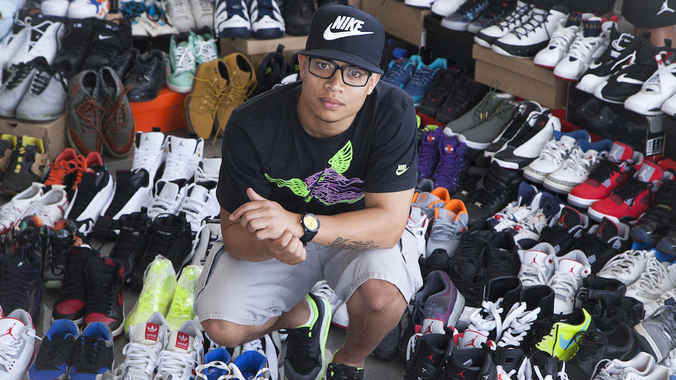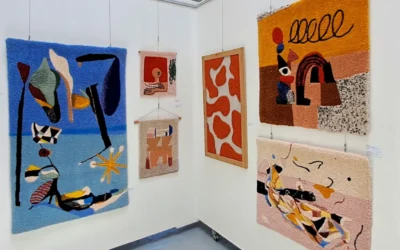No more tacky takkies: there’s a whole subculture devoted to collecting high-end sports shoes writes Nobhongo Gxolo.
Typically, the prologue begins with a child’s face pressed up against a store window, flanked by sticky fingers staining the glass that separates them from the sneaker display. The multitude of colour compels. Aspiration meets desperation as the child begins plotting how he’s going to get what he can’t have. His mother beckons for him to keep up; she has neither the time nor the money for such a distraction.
For the six sneaker collectors who are gathered at Sussex Studios in Woodstock, one of Cape Town’s urban renewal zones, a version of this story would resonate with how collecting started for each of them.
Except for rocking dope sneakers to accent any given day’s attire, the guys are pretty normal. By day they hold several different job titles. But in their spare moments and whenever they can find the time, they search online for the next footwear release. Conversations centre on who’s got which pair. Some of the guys are good friends; others are new to the fold. Still, they all share the common denominator of being a collector.
Eric Leeson (29), a financial planner from Kensington in Cape Town, calls himself a Jordan fanatic. He’s a family man who’s already started collecting for his sons; the youngest was born just last year.
This owner of 110 pairs of sneakers worth more than R130000 says, for him, sneaker culture stemmed from hardship. Growing up, you only got the things you needed. “I honestly had three pairs: school shoes, a pair for PT [physical training], a pair I went out with – and that was it.
“When I grew up, my mother was buying cheap shoes. I got my first pair of Nikes on my 13th birthday. But I couldn’t keep them. Your cousin didn’t have shoes, so you handed them down to him and he handed them down to his cousin. Eventually they’d have their last walk and get thrown in the bin.”
Rolo Rozay (30) of Bishop Lavis rocks that Rick Ross swag. The Puma store manager shares a similar sentiment with Leeson, explaining that some people misunderstand sneaker subculture. They think that buying each Jordan that comes out, or all the other releases, makes them sneakerheads – but they’re mistaken.
“There are people who buy the shoes that they couldn’t afford back when they were younger. Now they’ve got money – now they can get a hold of those shoes. Those are the people that I think are the elite few.” He adds that serious collectors don’t feel the need to showcase the “kicks” they own.
Justin Cameron (30) has been building up his footwear arsenal over the past decade. The green in Cameron’s oversized camouflage shorts is replicated in his cap and his sneakers. He imports most of his collection.
This Nike Air Max collector gets a call from a sales assistant at the Sportscene store in Canal Walk whenever a new pair is about to drop. He used to source them from the United States and the United Kingdom when he did work there.
But now that he’s back in South Africa, this light-hearted collector with undertones of a serious edge has started working at a car rental agency.
Pop culture chronicler Rob Lammle traces the beginnings of sneaker culture to the late 1970s in the Bronx, New York. As hip-hop gained traction and became popular in urban communities, the wardrobe received increasingly more attention.
The makings of a sneakerhead
There are as many versions of what defines a sneakerhead as there are sneakerheads. For some it’s a matter of persistence.
Twenty-six-year-old Athlone resident Yaaseen Khan wears the title as a badge of honour. His black sneakers have purple and orange zigzags on them. His cap is orange; his black shirt has orange Nike insignia on it. Khan owns 129 kicks, the earliest of which were amassed as a teenager.
Mandisi Lean (24) is based in Ekurhuleni, east of Johannesburg. He’s a self-professed sneakerhead. He also customises, repairs and refurbishes leather sneakers. He says to be afforded sneakerhead rights requires a degree of comprehension about sneaker culture. For him, it takes “a valid knowledge of the influencers that have an impact on the sneaker consumer culture – the musicians and other creatives that collaborate with big sneaker brands.
Twenty-five-year-old sales co-ordinator Ryan Herman jokes that being a sneakerhead has its drawbacks, or what he terms sneaker problems. “You match your sneakers to your clothes – but not too much. Not full out.
“Some people say we’re worse than girls because you sit in front of your closet and you’re like: ‘What goes with what? What am I gonna wear today?’ It takes time.”
Art dealer and gallerist João Ferreira is excited by the move that has made contemporary culture collectable. Noting the investment opportunities, he says: “The collectable clothing market has grown substantially and so will the niche sneaker market with the dissemination of information, the growth of the interest group, exhibition in important spaces and being sold at auction.”
Full report see Mail & Guardian
PHOTO CREDIT: Sneakerhead: Ryan Herman. (Dylan Culhane/Sportscene)






